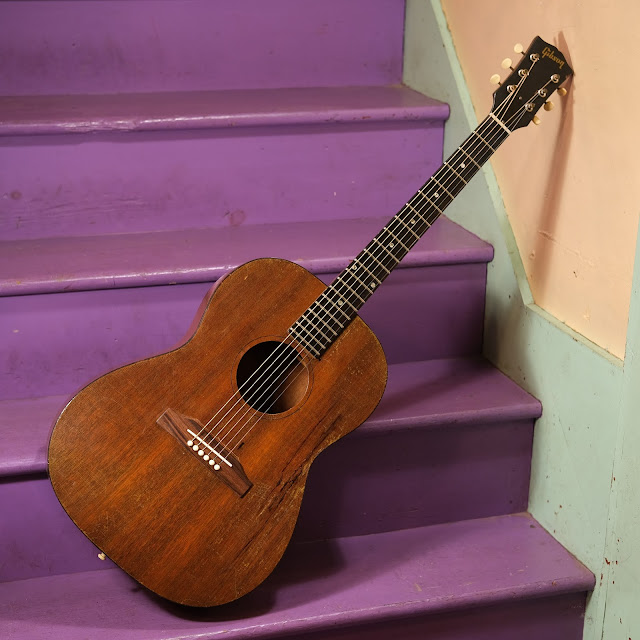1964 Gibson LG-0 Flattop Guitar
Ah, the venerable LG-0. These get more and more and more popular every year. Vintage Gibsons of all stripes are getting harder and harder to come by because of that.
This one's a '64 which means it has the more-desirable 1 11/16" nut width and medium-slim neck profile rather than the 1 5/8" (or skinnier: many are 1 9/16") nut width that was introduced over the next year of production and became standard until the '70s.
Fingerpickers, country-blues types, and folkies tend to really get along with these guitars. They're all-solid mahogany throughout the body and that combined with the ladder-braced design gives them a woody, mids-up-front sound that pairs-well with heavier picking attacks and strummy '60s folk-style rhythm. They have decent volume and punch and their 00-size measurements and short scale make them comfortable players for a wide range of body types.
This one has seen some repairs done in the past -- there's a cluster of longer hairline cracks on the treble-side top that have been filled and cleated and the original plastic bridge was replaced with rosewood. I worked on it a bit more and now it's both looking better and playing spot-on with plenty of saddle adjustment room.
Repairs included: fret level dress, bridge reprofiling (to look more Gibson-y), restring, and setup.
Top wood: solid mahogany
Back & sides wood: solid mahogany
Bracing type: ladder
Bridge: rosewood
Fretboard: rosewood
Neck wood: mahogany
Action height at 12th fret: 3/32” bass 1/16” treble (fast, spot-on)
String gauges: 52w, 40w, 30w, 22w, 16, 12 custom set
Neck shape: slim-med C
Board radius: ~12"
Truss rod: adjustable
Neck relief: straight
Fret style: medium-wide but shorter
Scale length: 24 5/8"
Nut width: 1 11/16"
Body width: 14 1/2"
Body depth: 4 1/2"
Weight: 4 lbs 0 oz
Condition notes: it has weather-check and finish-cracking throughout with discoloration here and there. This is really typical for this model. There are a cluster of repaired hairline cracks on the treble-side top (you can see the darker streaks where they are) and all have cleats and are good to go. The bridge is a replacement but that's good because the original plastic ones were terrible. The original pickguard is long gone and seems to have come off the guitar when it was fairly young as there's no discoloration as if it were left on for a long time -- just filled marks where the pickguard screws would have been. The top does have belly below and behind the bridge as you'd expect (I've never seen one with a flat top -- the bracing does not allow for it) but the bracing is all tight, it's been stable for the couple months it's cooled its heels awaiting repair, and it's ready to go.
It comes with: an old chip case.


















Comments